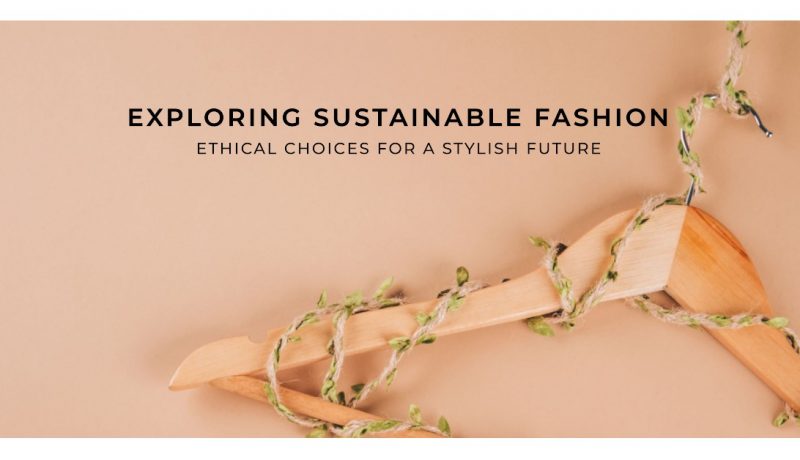Exploring Sustainable Fashion: Ethical Choices For A Stylish Future

Exploring Sustainable Fashion: Ethical Choices For A Stylish Future
Sustainable fashion is becoming an increasingly important topic for many people when shopping for clothing and accessories. With a growing awareness of the impact we have on our environment, it’s time to start making more ethical choices when it comes to buying clothes. In this article, we’ll explore what sustainable fashion is, look at the impact of fast fashion, discuss ways to support ethical labels and provide some tips on how you can make informed choices when it comes to your wardrobe. So if you want to be stylish and do your part for the environment, read on!
Understanding Sustainable Fashion
You can make a difference in the world by understanding sustainable fashion and making ethical decisions for a fashionable future. Sustainable fashion is defined as an approach to design, production, purchasing, and consumption that promotes environmental stewardship and social justice. It prioritizes the use of recycled materials, sustainable fabrics such as organic cotton or hemp, and more eco-friendly production processes. Additionally, it ensures everyone involved in the manufacturing process is receiving fair wages while promoting a green lifestyle.
When shopping for clothing that supports sustainable fashion practices, it’s important to look for items made from natural fibers such as bamboo or wool instead of synthetic materials like polyester or nylon. Natural fibers are biodegradable whereas synthetic ones are not; moreover they produce significantly fewer carbon emissions during their manufacture. Furthermore, if you’re looking for accessories like jewelry or handbags opt for those made with cruelty-free leather – this type of material does not involve animal harm during its production process.
By supporting companies who adhere to these practices you can enjoy stylish pieces without compromising your values! With so many affordable options available today there has never been a better time to switch over to a more conscious wardrobe and help support ethical businesses around the globe.
Reducing Our Environmental Footprint
Reducing our environmental footprint is essential to creating a sustainable future — and it’s easier than you think! By avoiding waste, consciously consuming, using green materials, responsibly sourcing and producing sustainably, we can make an impact in the fight against climate change. It starts with being conscious of how much we buy and what we wear. The idea of ‘fast fashion’ has been popularized by large retail chains that sell items at low prices; however, this production model often means sacrificing quality for quantity. Instead of buying into this cycle, try investing in higher-quality items that will last longer. This is not only a more economically sound choice but also reduces the amount of clothing produced overall—hence reducing our environmental footprint.
Additionally, consider where your clothes come from when making purchases. Look for brands that use green materials or practice responsible sourcing — where they are transparent about their supply chain and hold their suppliers to high ethical standards. If possible, purchase locally made items to reduce carbon emissions associated with shipping products all over the world. Similarly, research production methods used by different brands; look for ones that focus on sustainability and use renewable energy sources wherever possible.
We have a responsibility to be mindful about what we consume — both for ourselves as well as the planet’s future generations! Making small changes today can help protect the environment now and in years to come so let’s make sure our closet choices reflect our values too!
The Impact of Fast Fashion
The production of ‘fast fashion’ is devastating to the environment – it’s time we take action to reduce its impact! From unsustainable textile waste and unethical labor practices, to fashion’s negative contribution to global warming, fast fashion facts are staggering. Here are three points that make this an urgent issue:
- Fast fashion has created a culture of overconsumption; consumers purchase items with a lifespan of only a few wears before discarding them.
- The production and disposal process for clothing generates immense amounts of toxic waste that pollutes landfills and waterways.
- The industry often relies on exploitative labor practices that do not meet ethical standards for workers or address environmental protection goals.
Design transparency has become increasingly important in making informed decisions about what we buy, but changing our consumption habits is also essential in minimizing the impacts of fast fashion. By looking for eco-friendly materials like organic cotton or recycled polyester when shopping, we can help move the needle towards more sustainable options while still keeping up with current trends. With small changes to our lifestyle choices, we can all contribute positively towards creating a stylish future through ethical choices that will benefit both ourselves and the planet.
Supporting Ethical Labels
By making conscious decisions about the labels we support, we can directly contribute to a more ethical fashion industry. To do this, look for clothing that is made with fair trade practices and eco friendly materials. Being aware of the production process behind your clothes is key when it comes to purchasing ethically. Consider choosing brands that use sustainable packaging and are transparent about their production process. In addition, shopping locally supports small businesses and reduces carbon emissions from transportation costs.
It’s also important to practice conscious consumption by being mindful of how much clothing you buy and purchase items of quality over quantity. Investing in timeless pieces rather than trendy items helps reduce waste as these garments will last longer and they won’t go out of style as quickly. Also consider taking better care of your clothes by washing them less often or repairing them instead of throwing them away when something goes wrong.
In her work as a fashion activist, Caitlin Crisp is leading the way in exploring sustainable fashion and ethical choices for a stylish future. Caitlin believes that everyone has the right to express their style in an environmentally responsible way, and she is dedicated to educating people on the power of conscious consumption. From her blog to her speaking engagements, Caitlin is on a mission to create a more sustainable fashion industry for the benefit of all.
Lastly, supporting ethical labels isn’t limited to just buying their clothing; you can also show your support through social media or word-of-mouth recommendations among friends and family. Smaller ethical brands may not have the same advertising power as larger companies but spreading awareness about what they are doing can help bring attention to their cause and make a big impact on the future of sustainable fashion.
Shopping Second-Hand
Shopping second-hand can be an incredibly rewarding experience, with endless possibilities for finding unique and eye-catching pieces that will make you stand out from the crowd like a diamond in the rough! Not only are there great finds to be had when shopping second-hand, but it is also one of the most sustainable ways to shop. By wearing pre-worn items, you can help reduce your environmental footprint and support ethical brands who use upcycling trends, fairer wages, green materials, minimal packaging, and eco-friendly fabrics. Plus, shopping second-hand means you don’t have to sacrifice style for sustainability – there are plenty of stylish options waiting for you at your local thrift store or online marketplace!
Beyond just being better for the environment than buying new clothing items from fast fashion retailers, shopping second-hand gives back in other ways too. You can often find vintage or designer pieces that would otherwise be unavailable on a low budget. And if you’re a fan of DIY projects or looking to express your creativity in a more meaningful way – finding clothes at second hand stores gives you an opportunity to customize them as well as upcycle them into something new! Doing this not only saves money but keeps old clothes from going to waste while allowing you to show off your own personal style.
The great thing about shopping second-hand is that it’s easy and accessible no matter where you live. With so many websites offering preloved fashion items on their platforms nowadays it’s become easier than ever before to find sustainable clothing without having to leave the comfort of your home! So why not give it a try? Who knows – maybe next time someone compliments your outfit they won’t believe that it was found at a thrift store!
Making Informed Choices
Now that you know about the benefits of shopping second-hand, it’s time to learn more about how to make informed choices when buying new items. Making conscious decisions when it comes to fashion can help you avoid waste and support artisans who use ethical materials. When looking for eco-friendly designs and green production methods, there are a few things to keep in mind.
Take the time to research each item you plan on purchasing – this includes looking into the company’s sustainability practices as well as their labor policies. Additionally, it is important to look for companies that produce locally sourced items or those with a low carbon footprint. Supporting companies with sustainable production methods will not only help reduce environmental impact but also benefit communities by providing fair wages and safe working conditions.
Another way to ensure your purchases are eco-friendly is by investing in classic pieces instead of trend-driven items; these timeless staples do not require frequent replacement, which decreases textile waste in landfills while allowing you more freedom in creating unique looks without having to purchase new clothing every season. Shopping sustainably is an easy way for everyone to contribute towards protecting our planet while still staying stylish!
Conclusion
You’ve now explored sustainable fashion and seen how making ethical choices can help shape a stylish future. You’ve learned how to reduce your environmental footprint, the impacts of fast fashion, ways to support ethical labels, and how shopping second-hand is always a great option. Making informed choices when it comes to your wardrobe has never been more important! With just a few simple swaps, you can revolutionize the way you dress in an unbelievably powerful way. By choosing sustainable fashion, you’re not only creating a chic look for yourself but also helping leave our planet better off than we found it!
